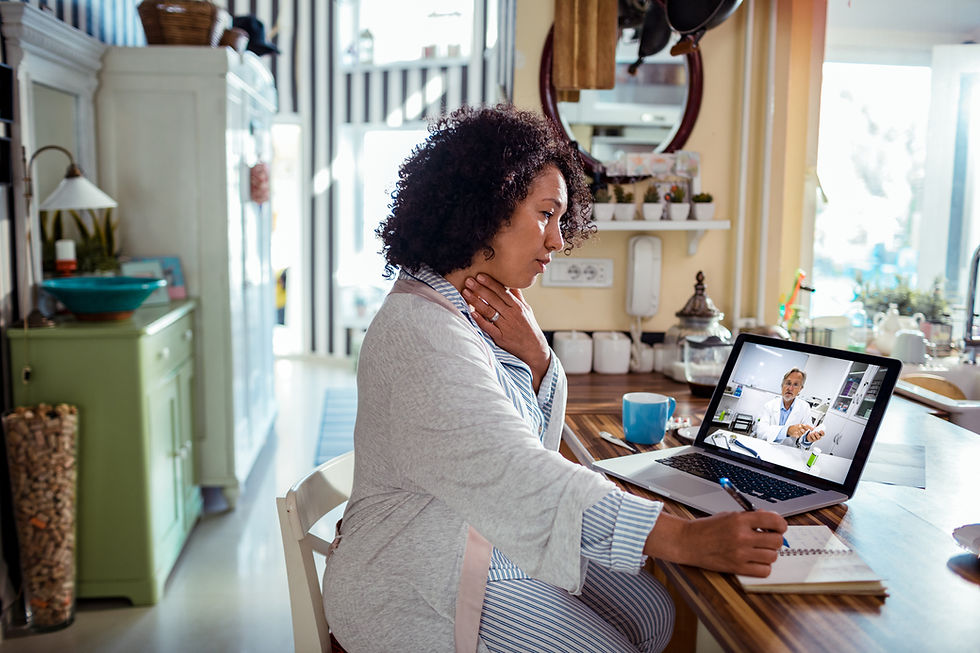In-Person or Online? Exploring the Effectiveness of Tele-rehabilitation
- Dr. Armaan

- Aug 29, 2023
- 4 min read
Today we are discussing the efficacy of receiving physiotherapy and chiropractic services online. Does it even work? Can you speak with a healthcare practitioner to receive advice and guidance to help improve your functional abilities and help you manage your pain? Meaning just some advice and guidance can actually take pain away…

Quick answer - Yes. Yes it can.
Research findings show that online therapy is as effective as in-person therapy for a range of conditions, including musculoskeletal, neurological, and cardiorespiratory conditions. The benefits of tele-rehabilitation range widely - from daily aches/pains to sport specific advice, post-surgical rehab, strength training guidance, those recovering from surgery and elderly patients that want to move with more confidence. With Telehealth services becoming more widely available, patients can now access quality physiotherapy and chiropractic services from the comfort of their homes. Online guidance is convenient, safe and ensures that your rehab is in your hands.
Anytime you see a healthcare practitioner, whether in-person or online - it should look something like this:
Time is spent to really listen to your concerns. Your individual goals are the first priority.
Questions are asked regarding your specific injury.
As well as examining your health as a whole. How you are moving, sleeping, working, eating, etc. And how you currently feel about your health.
Screen for “red flags”. Which are signs and symptoms found in the patient history and during the clinical examination that may tie a certain symptom to a possibly serious pathology.
A physical exam is then conducted online or in the office. During this, the goal is to re-create the discomfort you are feeling so we can identify a cause and develop a treatment plan.
Finally the plan is created to help you with your pain.
This will often include treatments in clinic, or at home, as well as, exercises and movements to alleviate some discomfort. Finally we also chat about lifestyle factors and preventative tips for after this injury is resolved.
The major pro and con of online therapy is how much emphasis is placed in YOUR hands. With online care YOU are the driver of your own recovery. Our job is to be your guide along the path and make sure you are receiving the right guidance and accountability.
So if online treatment is so great, when should you come into the clinic?
Coming into the clinic is necessary in certain cases and greatly beneficial in many others. Manual treatments from a physiotherapist, chiropractor, acupuncturist or massage therapist involve manually manipulating muscles and joints in the body to help individuals gain range of motion and alleviate pain. Certain conditions benefit from a different proportion of in-clinic and at-home management and this is where speaking to a professional is crucial.
Additionally, in the clinic we are able to utilize therapy equipment such as IFC (TENS) machines, acupunture, therguns, ultrasounds, shockwave, heat/cold therapy, paraffin wax, cupping etc to better aid in recovery and performance. We are also able to observe in more detail the intricate movements that you are struggling with. And we can utilize manual therapies to help you feel better sooner.
We all know that movement and mobility is key to a long and healthy life. Our goal is to work with you and ensure that you are able to do the activities that you enjoy for the rest of your life. Regardless of whether you speak with us online or come into the clinic - our first goal is to get you through this painful or uncomfortable state, then we work on prevention and optimization of your body. Because “Movement is a medicine for creating change in a person’s physical, emotional and mental state.”
Disclaimer: Much of the information for this post has been adapted from a course by Aaron Kubal on the benefits and implementation of tele-health. That being said, what we are stating in this blog is coming completely from RehabAcademy.
Aaron Kubal course on Tele-health. https://www.twincitiesrehab-performance.com/about
References:






Comments